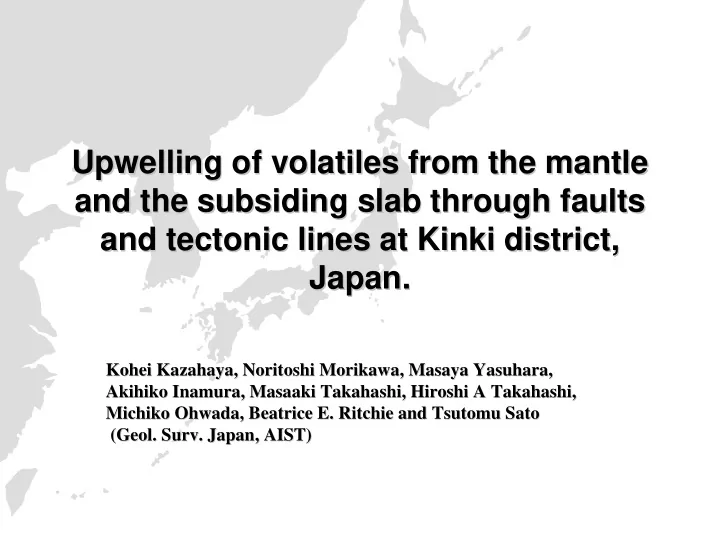

Upwelling of volatiles from the mantle Upwelling of volatiles from the mantle and the subsiding slab through faults and the subsiding slab through faults and tectonic lines at Kinki district, and tectonic lines at Kinki district, Japan. Japan. Kohei Kazahaya, Noritoshi Morikawa, Masaya Yasuhara, Kohei Kazahaya, Noritoshi Morikawa, Masaya Yasuhara, Akihiko Inamura, Masaaki Takahashi, Hiroshi A Takahashi, Akihiko Inamura, Masaaki Takahashi, Hiroshi A Takahashi, Michiko Ohwada, Beatrice E. Ritchie and Tsutomu Sato Michiko Ohwada, Beatrice E. Ritchie and Tsutomu Sato (Geol. Surv. Japan, AIST) (Geol. Surv. Japan, AIST)
Water circulation at subduction Water circulation at subduction Where does non- Magmatic fluid: 100-1000C, pH 0-2 volcanic thermal fluid Non-magmatic fluid: 20-300C, pH 3-9 come from? Amounts of CO2 degassing at 2000m-deep Stagnant water: 10-80C, pH 8-9 火山 地熱地帯 降水 Origin of Arima-type thermal water 涵養域 背弧グラーベン 地下水 停滞水 ? ? 固化マグマ 流出域 マグマ溜り 油田塩水 ? ? 海水 停滞水 ? ? 大陸地殻 付加体 活断層 海洋地殻 マントル 脱水反応 マントル マントルダイアピル スラブ
Non- -magmatic thermal water: magmatic thermal water: Non Isotopically categorized as categorized as “ “Arima Arima- -type type” ” Isotopically brine (Matsubaya Matsubaya and Sakai 1976) and Sakai 1976) brine ( Origin and genesis is unknown Origin and genesis is unknown This is the target of this study using geochemical and hydrological methods
Arima- -type thermal brines type thermal brines Arima The location where Arima-type thermal brine found Kashio Arima Kobe Ishibotoke Wakayama More than 500 groundwater MTL have been investigated ・ Chemical composition ・ Isotope ratios
Chemical and isotopic evidence Chemical and isotopic evidence for origin and genesis of for origin and genesis of Arima- -type water type water Arima
after Giggenbach (1993)
Comparison between Arima- -type thermal type thermal Comparison between Arima fluid and island- -arc magmatic water arc magmatic water fluid and island Similar chemical and isotopic feature Arima-type magmatic
Origin of Arima-type fluid? Not magmatic
But has similar chemical and isotopic composition The same genetic nature and origin?
Missing water
A Question Arima-type fluid come from subducting slab? Arima-type fluid is the answer for the missing water? To answer the question Flux measurement of Arima-type fluid and compare with missing water flux
Photos showing wells and self-spouting outcrops Short visit to the field at Arima, Gosha and Ishibotoke In Kinki district, Central Japan
詳細調査地域 詳細調査地域
1)Self-spouting from cracks of rocks Ishibotoke Ishibotoke 2)CO 2 -bearing 3)Higher than river water level
Ishibotoke Ishibotoke
Flux measurement of Arima-type fluid
Arima area
* >4 l /sec after Morikawa et al. (2005)
and compare with missing water
Shallow groundwater circulation: 4 x 10 5 l/sec
>4 l /sec Agree well with each other Missing water: 4-35 l /sec
Arima-type water has similar chemical and isotopic composition as magmatic water has. → Similar genetic process → Originated from slab dehydration Arima-type water flux agree well with that of missing water of water circulation in the solid earth. → Strong evidence for the model of Arima-type fluid genesis
Arima-type has only found at southwest Japan! Especially in Kinki district! Why? Difference in plate character?
Philippine Sea Plate is young, thin and hot Easy to dehydrate? Effective dehydration occurs at Philippine Sea Plate
Summary ・ Wide distribution of Arima-type thermal brine is found. ・ Flux of Arima-type fluid is consistent with amount of missing water estimated from water circulation in solid earth. ・ Arima-type fluid likely occur by dehydration of subducting slab and upwell through tectonic lines and faults.
Future study ・ Reveal relation of Arima-type activity with geological structure and seismic activity ・ Proceed measurement of Arima-type regional flux in different area ・ Compare chemical and isotopic difference between the fluids from different Plates
Spatial distribution of Arima- -type type Spatial distribution of Arima After Masaaki Takahashi
Recommend
More recommend